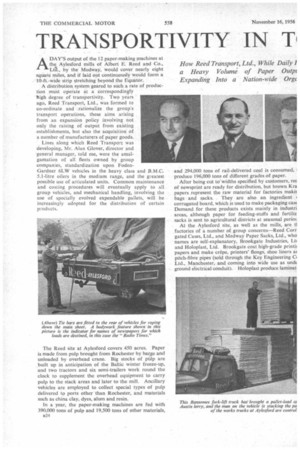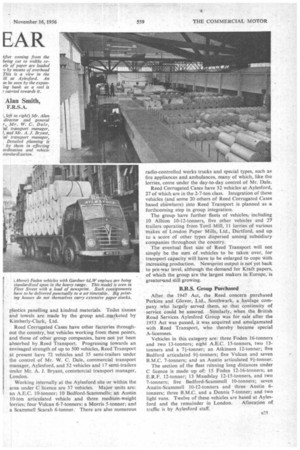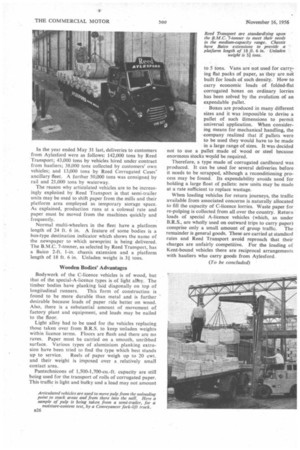TRANSPORTIVITY IN Ti EAR
Page 58

Page 59

Page 60

If you've noticed an error in this article please click here to report it so we can fix it.
How Reed Transport, Ltd., While Daily .1 a Heavy Volume. of Paper Olitpz Expanding Into a Nation-wide Orgc
Alan Smith,
F.R.S.A.
ADAY'S output of the 12 paper-making machines at the Aylesford mills of Albert E. Reed and Co., Lt., by the Medway, would cover nearly eight square miles, and if laid out continuously would form a 10-ft.-wide strip stretching beyond the Equator.
A distribution system geared to such a rate of production must operate at a correspondingly high degree of transportivity. Two years ago, Reed Transport, Ltd., was formed to co-ordinate and , rationalize the group's transport operations, these aims arising from an expansion policy involving not only the raising of output from existing establishments, but also the acquisition of a number of manufacturers of paper goods.
Lines along which Reed Transport was developing, Mr. Alan Glover, director and general manager, told me, were the amalgamation of all fleets owned by group companies, standardization upon FodenGardner 6LW vehicles in the heavy class and B.M.C. 5.1-litre oilers in the medium range, and the greatest possible use of articulated units. Common maintenance and costing procedures will eventually apply to all group vehicles, and mechanical handling, involving the use of specially evolved expendable pallets, will be increasingly adopted for the distribution of certain products.
The Reed site at Aylesford covers 450 acres. Paper is made from pulp brought from Rochester by barge and unloaded by overhead crane. Big stocks of pUlp are built up in anticipation of the Baltic winter freeze-up, and two tractors and six semi-trailers work round the clock to supplement the overhead equipment to carry pulp to the stack areas and later to the mill. Ancillary vehicles are employed to collect special types of pulp delivered to ports other than Rochester, and materials such as china clay, dyes, alum and resin.
In a year, the paper-making machines are fed with 390,000 tons of pulp and 19,500 tons of other materials, 1324 and 294,000 tons of rail-delivered coal is consumed, produce 196,000 tons of different grades of paper.
After being cut to'widths specified by customers, ree of newsprint are ready for distribution, but brown Kra papers represent the raw material for factories makit bags and sacks. They are also an ingredient • corrugated board, which is used to make packaging cast Demand for these products exists mainly in industri areas, although paper for feeding-stuffs and fertiliz sacks is sent to agricultural districts at seasonal perioc At the Aylesford site, as well as the mills, are ti factories of a number of group concerns—Reed Corr gated Cases, Ltd., and Medway Paper Sacks, Ltd., who names are self-explanatory, Brookgate Industries, Ltt and Holoplast, Ltd. Brookgate coat high-grade printii papers and make crêpe, printers' flongs, shoe liners at pitch-fibre pipes (sold through the Key Engineering 0 Ltd., Manchester, and coming into wide use as undc ground electrical conduit). Holoplast produce laminat plastics panelling and kindred materials. Toilet tissues and towels are made by the group and_rnarketed by Kimberly-Clark, Ltd.
Reed Corrugated Cases have other factories throughout the country, but vehicles working from these points, and those of other group companies, have not yet been absorbed by Reed Transport. Progressing towards an envisaged strength of up to 500 vehicles, Reed Transport at present have 72 vehicles and 35 semi-trailers under the control of Mr. W. C. Dale, commercial transport manager, Aylesford, and 52 vehicles and 17 semi-trailers under Mr. A. J. Bryant, commercial transport manager, London.
Working internally at the Aylesford site or within the area under C licence are 37 vehicles. Major units are: an A.E.C. 10-tonner; 10 Bedford-Scammells; an Austin 10-ton articulated vehicle and three medium-weight lorries; four Vulcan 6-7-tonners; a Morris 5-tonner; and a Scammell Scarab 6-tonner. There are also numerous radio-controlled works trucks and special types, such as fire appliances and ambulances, many of which, like the lorries, come under the day-to-day control of Mr. Dale.
Reed Corrugated Cases have 32 vehicles at Aylesford, 27 of which are in the 2-7-ton class. Integration of these vehicles (and some 20 others of Reed Corrugated Cases based elsewhere) into Reed Transport is planned as a forthcoming step in group integration.
The group have further fleets of vehicles; including 10 Albion 10-12-tormers, five other vehicles and 27 trailers operating from Tovil Mill, 11 lorries of various makes of London Paper Mills, Ltd., Dartford, and up to a score of other types dispersed among subsidiary companies throughout the country.
The eventual fleet size of Reed Transport will not simply be the sum of vehicles to be taken over, for transport capacity will have to be enlarged to cope With increasing production. Newsprint output is not yet back to pre-war level, although the demand for Kraft papers, of which the group are the largest makers in Europe, is greaterrand still growing.
B.R.S. Group Purchased
After the 1947 Act, the Reed concern purchased Perkins and Glover, Ltd., Southwark, k haulage company who largely served them, so that continuity of service could be assured. Similarly, when the British Road Services Aylesford Group was for sale after the 1953 Act was passed, it was acquired and amalgamated with Reed Transport, who thereby became special A-licensees.
Vehicles in this category are: three Foden 16-tonners and two 13-tonners; eight A.E.C. 15-tonners, two 13tonners and a 71-tormer; an Atkinson 12-tonner; five Bedford articulated 94-tonners; five Vulcan and seven B.M.C. 7-tonners; and an Austin articulated 91-tonner.
The section of the fleet 'timing long distances under C licence is made up of: 15 Foden 12-I6-tonners; an E.R.F. 12-tonner; 13 Maudslay 12-15-tonners, and two 7-tonners; five Bedford-Seammell 10-tonners; seven Austin-Scammell 10-12-tonners and three • Austin 6tonners; three B.M.C. and a Dennis 7-tonner; and two light vans. Twelve of these vehicles are based at Ayles In the year ended May 31 last, deliveries to customers from Aylesford were as follows: 142,000 tons by Reed Transport; 43,000 tons by vehicles hired under contract from hauliers; 38,000 tons collected by customers' own vehicles; and 13,000 tons by Reed Corrugated Cases' ancillary fleet. A further 50,000 tons was consigned by rail and 21,000 tons by waterway.
The reason why articulated vehicles are to be increasingly exploited by Reed Transport is that semi-trailer units may be used to shift paper from the mills and their platform area employed as temporary storage space. As explained, production runs at a colossal rate and paper must be moved from the machines quickly and frequently.
Normal multi-wheelers in the fleet have a platform length of 24 ft. 6 in. A feature of some bodies is a bus-type destination indicator which shows the name of the newspaper to which newsprint is being delivered. The B.M.C. 7-tonner, as selected by Reed Transport, has a Baico 2-ft. 1-in, chassis extension and a platform length of 18 ft. 6 in. Unladen weight is 31 tons.
Wooden Bodies' Advantages
Bodywork of the C-licence vehicles is of wood, but that of the special-A-licence types is of light alloy. The timber bodies have planking laid diagonally on top of longitudinal runners. This form of construction is found to be more durable than metal and is further desirable because loads of paper ride better on wood. Also, there is a substantial amount of movement of factory plant and equipment, and loads may be nailed to the floor.
Light alloy had to be used for the vehicles replacing those taken over from B.R.S. to keep unladen weights within licence terms. Floors are flush and there are no raves. Paper must be carried on a smooth, unribbed surface. Various types of aluminium planking extrusion have been tried to find the type which best stands up to service. Reels of paper weigh up to 20 cwt.
and their weight is imposed over a relatively small• contact area.
Pantechnicons of 1,500-1,700-cu.-ft. capacity are still being used for the transport of rolls of corrugated paper. This traffic is light and bulky and a load may not amount to 5 tons. Vans are not used for carrying flat packs of paper, as they are not built for loads of such density. How to carry economic loads of folded-flat corrugated boxes on ordinary lorries has been solved by the evolution of an expendable pallet.
Boxes are produced in many different sizes and it was impossible to devise a pallet of such dimensions to permit universal application. When considering means for mechanical handling, the company realized that if pallets were to be used they would have to be made in a large range of sizes. It was decided not to use a pallet made of wood or steel because enormous stocks wo,uld be required.
Therefore, a type made of corrugated cardboard was produced. It can be used for several deliveries before it needs to be scrapped, although a reconditioning process may be found. Its expendability avoids need for holding a large float of pallets: new units may be made at a rate sufficient to replace wastage.
When loading vehicles for return journeys, the traffic available from associated concerns is naturally allocated to fill the capacity of C-licence lorries. Waste paper for re-pulping is collected from all over the country. Return loads of special A-licence vehicles (which, as under B.R.S., are wholly used on outward trips to carry paper) comprise only a small amount of group traffic. The remainder is general goods. These are carried at standard rates and Reed Transport avoid reproach that their charges are unfairly competitive. For the loading of Kent-bound vehicles there are reciprocal arrangements with hauliers who carry goods from Aylesford.




















































































































